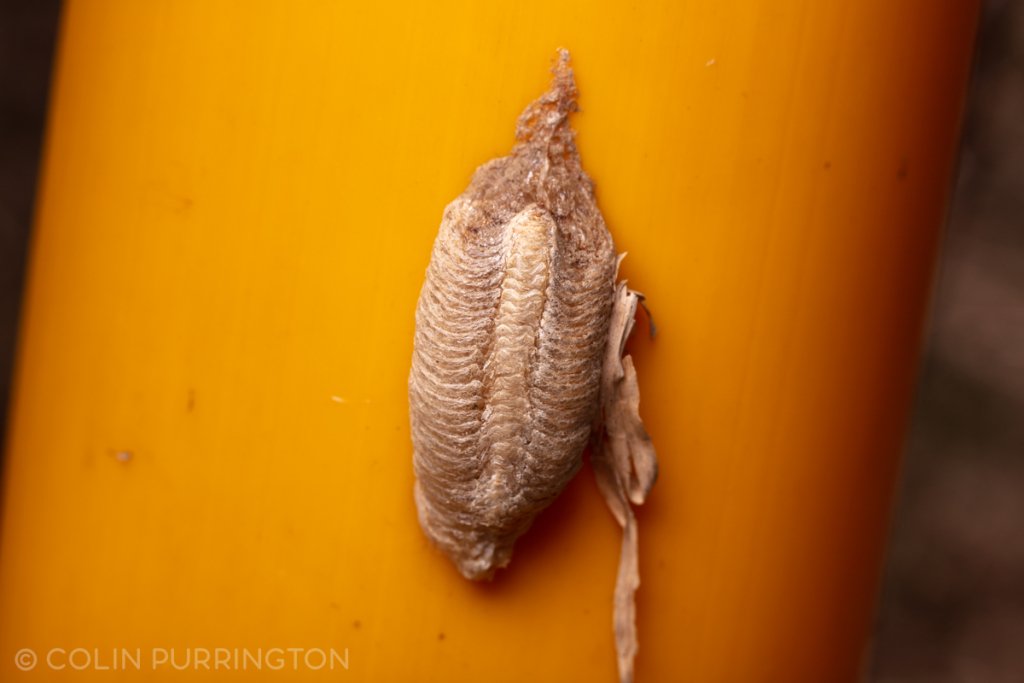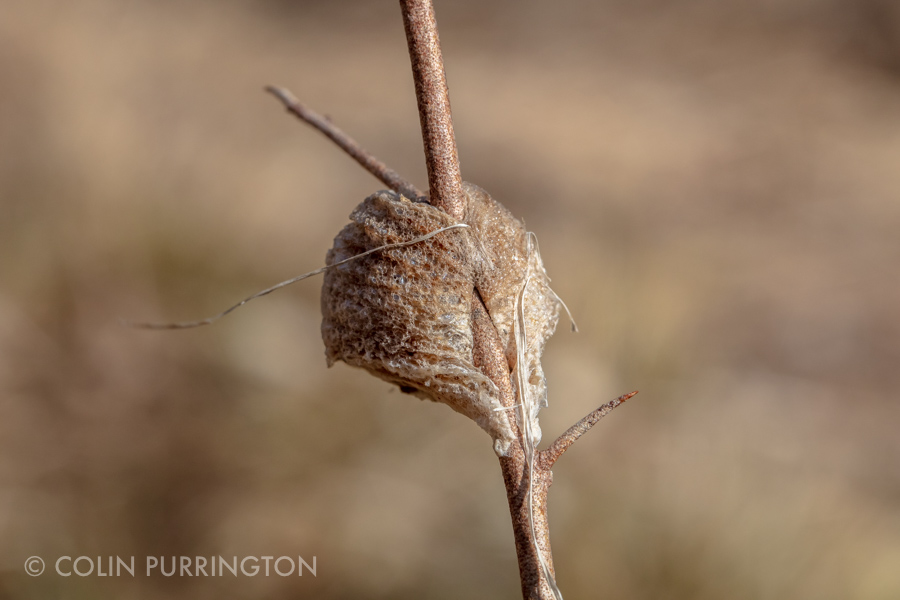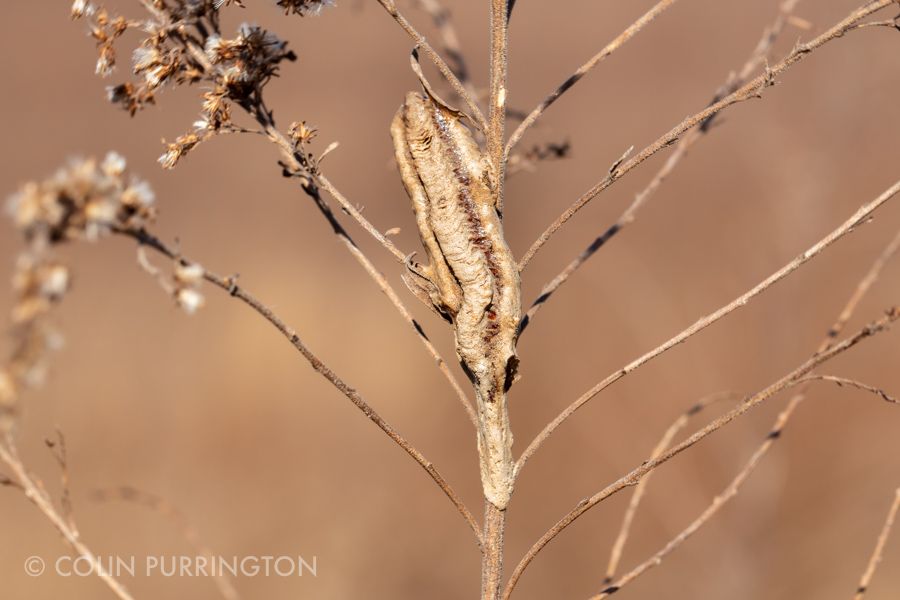Below are photographs and descriptions of egg cases of the (native) Carolina mantis, the European (=praying) mantis, the Chinese mantis, and the narrow-winged mantis.
Carolina mantid (Stagmomantis carolina)
Carolina mantids (the only native species in my area) form relatively smooth, teardrop-shaped oothecae with a central portion that is lightly colored. Often found on tree trunks, rocks, and buildings.
European mantis (Mantis religiosa)
These oothecae are somewhat similar to the Carolina mantis’ but lack the alternating bands of color. Another common name for the European mantis is the praying mantis.

Chinese mantid (Tenodera sinensis)
Chinese mantid oothecae are typically roundish, roughly textured, and uniform in color. Introduced from Asia, as you probably guessed.
Narrow-winged mantid (Tenodera angustipennis)
Narrow-winged mantid oothecae are usually rather elongate. They are also seem to have red streaks, though the color seems to be most noticeable after they age a few months. Introduced from Asia, too.
More ID help
For an excellent overview of all of these species, please see the Cape May Wildlife Guide’s page on mantids. Please also see the excellent guide by Paweł Pieluszyński of the Brooklyn Bridge Park, especially because it includes an ootheca of the Asian jumping mantis (Statilia maculata) that is probably lurking undiscovered in Pennsylvania. If you need help identifying an ootheca, I highly recommend posting a photograph on iNaturalist. Not only will you get an answer from the iNaturalist community within a day or two, your submission helps scientists track the spread of invasive species.
What should you do with the non-native oothecae?
Invasive mantids eat butterflies, native bees, honey bees, small birds, and also the native mantid, so when you find egg cases, dispose of them. Here are some suggestions on how to do that:
- Put them in a freezer for a week
- Step on them
- Give them to a neighbor who has chickens
- Give them to local bird rehabilitation centers
- Give them to a neighbor who has a pet tarantula, snake, lizard, or fish
Whatever you do, please not just relocate oothecae to some nearby field — that just transfers the problem to someplace where you can’t see the problem.
But aren’t mantids great for pest control?
Although it’s true that young mantids consume a lot of insects, some of which might be pests, when mantids are fully grown they tend to camp out on flowers and wait for large butterflies and even small birds. Mantids are, of course, excellent for controlling butterflies and hummingbirds in case you happen to hate those animals.





I saw about 20 Chinese mantis egg cases at Hildacy preserve a few months ago :/
There’s a small tree at Hildacy with 12 egg cases. I wish Natlands would hold egg-case hunts on Easter. Would be great fun, and kids would really enjoy, too.
Curious to learn how you came up with your opinion?
Feel like this is just a high school essay, with no actual realistic facts…
My primary source is just my yard. Started noticing piles of monarch wings underneath certain plants, then realized it was likely the Chinese mantids camped out there. After a little research online, turns out that these mantids have a known ability to selectively eat the parts of monarchs and thus avoid the bulk of their toxicity.
Liked the pictures and articles. In Texas, the s carolina has also been observed with this behavior. I have a few every year that do this and it is just too hot for tenodera here. I also have some that seem to ambush small polistes as they fly in or out of the nesting area in bushes. They seem to become ‘specialists’ in a way and i would argue can tell the difference between males and females polistes, and ambush males that can’t sting.
The ability to ID and attack males would be incredible. Any chance you can tell sex of wasp in this pic?
Chinese mantises were introduced more than one hundred years ago, and have successfully integrated into our ecosystem–there’s no need to go destroying these magnificent insects. “Invasives,” whether plant or animal, are often subjected to xenophobic persecution for no valid reason. Nazi Germany was the first nation to legislate their exclusion. It is true that they can disrupt an ecosystem, but generally over time the problems they create will dissipate as the dynamics adjust. David Theodoropoulos’ out of print “Invasion Biology–Critique of a Pseudoscience” furnishes an excellent analysis, and addresses the hysteria to which we’ve all been subjected regarding this issue. Get a copy if you can find it!
I hadn’t heard that Hitler hated Chinese mantids. Thanks for the reading rec. I’ll check it out.
Exactly. This guy is dangerous with the words he’s putting out.
100 years is nothing in evolutionary time
I probably wouldn’t kill a Mantis sac if I had found one..but I’m glad that I did find a few Carolina mantis egg sacs on the shed here in Philadelphia today.
That’s fantastic!
No what’s fantastic is that a few weeks ago I actually picked this female mantis up off the sidewalk and put her in the grass. A few days later she was on my shed and has moved but hasn’t left. And I caught her eating a spotted lantern fly the other day… now she’s laid a sac or two
Promotion of smashing egg sacs of the mantids is sick and twisted. Completely uncalled for. They’ve been here since 1896 at least. You should be ashamed of yourself.
It’s an invasive species and has no benefit to the natural ecosystem, in fact it is a detriment. You should be ashamed of yourself for allowing your feelings to override logical thinking. Just because they have been here a long time doesn’t mean they magically should be. You are sick and twisted for not understanding how nature works and instead adopting a child’s mentality.
Meh, if Chinese mantises were such a menace, they wouldn’t still be coexisting with the natives, which aren’t endangered, 100 years later. There’s no point being xenophobic about the “invaders;” they’re not going anywhere and no evidence has emerged that they’re detrimental in the aggregate. They’ve integrated into the ecosystem and are fascinating and useful.
That’s how logical thinking is employed (and virtue signaling, moralistic shaming eschewed ; -).
Thank you for this post lol. People need to understand that not all “Invasive” animals are destructive. In fact, many have no impact on their environment what so ever.
Our indigenous flora and fauna evolved together for a very long time. “Since 1896” is really nothing on the evolutionary timescale, and introductions like these can upset interactions that have evolved over millennia.
New interactions will evolve, and they won’t take millennia. Just as we don’t expect things to be the same from place to place, neither should we expect that from time to time.
From what I have researched over the years about the Chinese Mantis (Tenodera sinensis), they have been proven to have no negative impact on North America’s ecosystem.
Yes originally they were considered an invasive species roughly 100+ years ago, but they are technically considered “well established” to the US like a majority of other “invasive” species (Asain Grass Carp, Tilapia, Peacock Bass, European Starlings etc).
Most invasive species actually have no negative impact on the surrounding native flora & fauna at all. While others such as (Solenopsis invicta) aka The Red Imported Fire Ant, is perhaps the most invasive, temperamental, destructive, dangerous ant species the Southeastern US deals with.
The picture above is actually the first time I have ever seen any mantid species prey upon the Monarch Butterfly (Which is a little disturbing). Usually most animals know to avoid the Monarch Butterfly/larvae due to Milkweed toxin.
I also dont see any point in destroying wild Chinese Mantid Ootheca just because It “technically” doesn’t belong in the US (Nymphs provide food for many US species. Some invasive species though need to be eradicated on sight tbh.
I have raised Chinese Mantids in captivity before and released newly hatched nymphs to control the Aphids, Scale Bugs, Spider Mites, Whiteflies, and Cut Worms feasting on my vegetable plants & herb gardens.
100+ years or so may not seem like a long time for an insect to be considered native/established, but if the Chinese Mantis was truly that destructive to all native fauna (like the Fire Ant), it would have wiped out (or nearly wiped out) other mantid species and a huge majority of other native species found in the US. 100+ years of Chinese Mantid breeding would have surely raised a massive red flag if they were that destructive to our environment.
I live in Central Florida and we have many species of mantids not found anywhere else in the US. Florida also harbors many invasive animals due to ideal environmental conditions, human negligence, stowaways from imported plants & furniture, even the accidental escapes from residential/commercial facilities.
Spotted Lantern Flies, Cuban Tree Frogs, Burmese Pythons, Nile Monitor Lizards, Red Imported Fire Ants, Citrus/Oak Borers are just a few that are actually very destructive in Florida.
In all honesty, I feel that the Chinese Mantis poses no significant threat/danger to North America’s native fauna. Many animals here easily prey upon Chinese Mantid nymphs & adults.
Sorry for the long response lol. The point im trying to make is that not all invasive animal species accidentally or purposely introduced into the US are destructive by any means. Btw folks (food for thought), the beloved American Wild West Icon (The Horse) is actually an invasive animal brought here to North America by the Spanish many many years ago .
Asian grass carp and starlings are considered invasive by ecologists.
Xenophobia refers to people.
Merriam Webster:
xenophobia noun
xe·no·pho·bia | \ ˌze-nə-ˈfō-bē-ə , ˌzē- \
Definition of xenophobia
: fear and hatred of strangers or foreigners or of anything that is strange or foreign
Perhaps in ancient times xenophobia referred exclusively to people, but modern usage extends its meaning to “anything that is strange or foreign.” Using it in the context of reflexive reactions to perceived “invasive” species, regardless of their impact, is appropriate. It doesn’t appear that the mantis onslaught has created the disruptions associated with the examples you cited (which are possibly overstated, but I grew up in Florida so know that real problems can occur, at least in the short term).
“Invasive” by definition is causing some unacceptable harm. If it was brought by humans but is not causing harm, it’s simply non native.
While not all non native species become invasive, waiting for something to become endangered is too high of a threshold.
By using the term “invasive”, it signifies some inherent danger or harm to the native habitat. I think what is meant in the context of this conversation is “native” or “non-native”. Status as an “invasive” can apply to native species in some cases. Invasive just means it’s outcompeting everything else in its class. For example: eastern red cedar (Juniperus Virginiana) can be invasive within its own native range. I think the claim that we tend to go a little overboard with the frantic cries about non-native species is indeed pretty ridiculous in many cases. But equally to the other side of that coin, it’s irresponsible to turn the other cheek or even go as far as to say it’s “xenophobic” to not be accepting and welcoming of nonnatives. I’m sure if the native fraxinus Americana had the ability, it wouldn’t appreciate its disapproval of the emerald ash borer being labeled as xenophobic. And I doubt the hundreds of bird and mammal species that depend on this tree would take that stance either. Small changes in ecology happen. Sometimes introductions adapt with very little impact or even fill a niche that wasn’t filled. However quick swings in declining biodiversity are often exacerbated by the one-two punches from human habitat loss and over competition from introduced predators or forage competitors. Nature is a somewhat delicate balance we have to consider while carving out our place within it.
I found some baby domestic house cats in my yard. They are not native to US which must mean they are invasive. Cats are considered to be the most common predator to hummingbirds. So I guess I need to step on these kittens, is that right? Or should I put them in a freezer for a week? Please help! I wanna do the right thing.
FYI – Native mantids can eat butterflies, native bees, honey bees too. They don’t have any union laws prohibiting it.